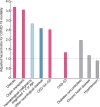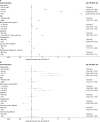Chronic kidney disease is a key risk factor for severe COVID-19: a call to action by the ERA-EDTA
- PMID: 33340043
- PMCID: PMC7771976
- DOI: 10.1093/ndt/gfaa314
Chronic kidney disease is a key risk factor for severe COVID-19: a call to action by the ERA-EDTA
Abstract
Diabetes, hypertension and cardiovascular disease have been listed as risk factors for severe coronavirus disease 2019 (COVID-19) since the first report of the disease in January 2020. However, this report did not mention chronic kidney disease (CKD) nor did it provide information on the relevance of estimated glomerular filtration rate (eGFR) or albuminuria. As the disease spread across the globe, information on larger populations with greater granularity on risk factors emerged. The recently published OpenSAFELY project analysed factors associated with COVID-19 death in 17 million patients. The picture that arose differs significantly from initial reports. For example, hypertension is not an independent risk factor for COVID-19 death [adjusted hazard ratio (aHR) 0.89], but renal disease very much is. Dialysis (aHR 3.69), organ transplantation (aHR 3.53) and CKD (aHR 2.52 for patients with eGFR <30 mL/min/1.73 m2) represent three of the four comorbidities associated with the highest mortality risk from COVID-19. The risk associated with CKD Stages 4 and 5 is higher than the risk associated with diabetes mellitus (aHR range 1.31-1.95, depending upon glycaemic control) or chronic heart disease (aHR 1.17). In another recent publication, the Global Burden of Disease collaboration identified that worldwide, CKD is the most prevalent risk factor for severe COVID-19. Moreover, the distribution of risk factors for COVID-19 mortality appears to be different in patients with CKD when compared with the general population. The high prevalence of CKD in combination with the elevated risk of mortality from COVID-19 in CKD necessitates urgent action for this group of patients. This article defines essential action points (summarized in Box 1), among which is advocating the inclusion of CKD patients in clinical trials testing the efficacy of drugs and vaccines to prevent severe COVID-19.
Keywords: COVID-19; chronic kidney disease; mortality; prevalence; renal replacement therapy; risk factor.
© The Author(s) 2020. Published by Oxford University Press on behalf of ERA-EDTA.
Figures




Comment in
-
COVID-19 and policy changes for kidney disease: the need for a 'decade of the kidney'.Nephrol Dial Transplant. 2021 Jan 1;36(1):8-11. doi: 10.1093/ndt/gfaa339. Nephrol Dial Transplant. 2021. PMID: 33377168 Free PMC article. No abstract available.
References
-
- World Health Organization. WHO Coronavirus Disease (COVID-19) Dashboard. https://covid19.who.int/ (4 October 2020, date last accessed)
-
- CNN World. Spanish 113-year-old speaks after surviving coronavirus. https://edition.cnn.com/2020/05/13/europe/spain-oldest-woman-coronavirus... (5 September 2020, date last accessed)
Publication types
MeSH terms
LinkOut - more resources
Full Text Sources
Other Literature Sources
Medical
Research Materials
Miscellaneous

